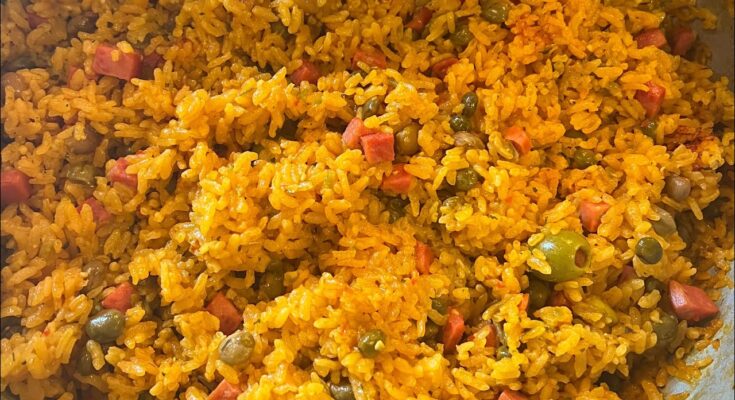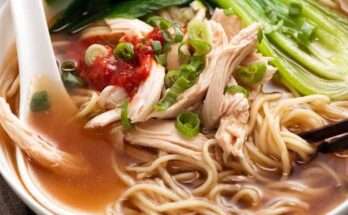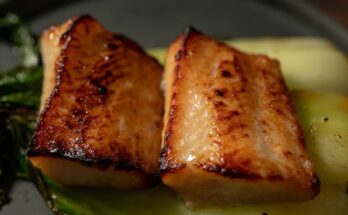Puerto Rican Rice Recipe: Puerto Rican rice, known locally as Arroz Puerto Riqueño, is more than just a side dish—it’s a symbol of Puerto Rican culture, family, and tradition. Whether you’re preparing a holiday feast or a casual Sunday dinner, no table is complete without a steaming pot of golden, fragrant rice. The secret lies in the blend of spices, herbs, and the magical sofrito that forms the base of nearly every Puerto Rican meal.
This rice isn’t just about filling your plate—it’s about evoking the comforting aroma that reminds every Puerto Rican of home. It’s rich in flavor, slightly smoky, and carries the essence of the Caribbean in every bite. Let’s take a flavorful journey through the ingredients and steps to make this classic dish at home, even if you’ve never cooked Puerto Rican food before.
The Heart of Puerto Rican Cuisine
Rice is the cornerstone of Puerto Rican cuisine. From Arroz con Gandules (rice with pigeon peas) to Arroz con Pollo (rice with chicken), it’s the soul of every meal. This dish combines native ingredients with Spanish and African influences, creating a flavorful fusion that defines Puerto Rican cooking.
Every household has its own version of Puerto Rican rice—some prefer it spicy, others mild. Some use achiote oil for color, while others rely on sazón seasoning. Yet, the foundation remains the same: sofrito, long-grain rice, and love.
Think of Puerto Rican rice as a warm hug in a bowl. It’s bold, colorful, and packed with personality—just like the island itself.
Ingredients You’ll Need
Making authentic Puerto Rican rice doesn’t require complicated ingredients, but it does depend on using the right ones. Here’s what you’ll need to capture that true island flavor:
Main Ingredients
- 2 cups long-grain white rice – The key to fluffy, non-sticky rice.
- 3 tablespoons olive oil or achiote oil – Adds color and richness.
- 1/2 cup sofrito – The soul of the dish (a blend of peppers, onions, garlic, cilantro, and herbs).
- 1 packet sazón seasoning (with annatto) – For vibrant color and flavor.
- 1 teaspoon adobo seasoning – A Puerto Rican essential for seasoning.
- 1/4 cup tomato sauce – Adds a slight tang and richness.
- 1/2 cup diced green olives (optional) – Adds a salty punch.
- 2 1/2 cups water or chicken broth – The liquid base for cooking.
- Salt to taste
Optional Add-Ins for Extra Flavor
- 1/2 cup pigeon peas or kidney beans – For heartiness.
- 1/2 cup chopped ham or sausage – For a meaty twist.
- 1 tablespoon capers – For an extra burst of briny flavor.
- Chopped cilantro – For garnish and freshness.
Ingredient Substitutions
If you can’t find traditional Puerto Rican ingredients in your local store, don’t worry. You can substitute:
- Achiote oil → Use olive oil mixed with paprika.
- Sofrito → Blend green bell pepper, garlic, onion, cilantro, and tomato.
- Sazón seasoning → Mix cumin, garlic powder, coriander, and turmeric for a homemade version.
With these, you can still make a dish that tastes authentic and delicious!
Tools and Equipment Required
Before diving into cooking, gather the right tools. The secret to perfect Puerto Rican rice isn’t just the ingredients—it’s also the pot you use.
Kitchen Essentials
- Large heavy-bottomed pot (caldero) or Dutch oven
- Wooden spoon for stirring
- Measuring cups and spoons
- Medium bowl for soaking rice (optional)
Choosing the Right Pot for Cooking Rice
The caldero—a traditional Puerto Rican cooking pot made of cast aluminum—is ideal for this recipe. Its thick walls distribute heat evenly, helping you achieve that famous pegao (crispy rice at the bottom). If you don’t have a caldero, a Dutch oven or heavy stainless-steel pot will work fine.
Avoid nonstick pots if you can—the pegao won’t form as nicely, and that’s one of the best parts of Puerto Rican rice!
Step-by-Step Guide to Making Puerto Rican Rice
Step 1 – Prepare Your Ingredients
Gather your essentials: 2 cups of medium-grain rice, 3 tablespoons of olive oil, ½ cup of sofrito (a blend of peppers, onions, garlic, and herbs), 1 can of tomato sauce, 1 packet of sazón seasoning, 1 teaspoon of adobo, ½ teaspoon of cumin, ½ teaspoon of oregano, and 3 cups of water or chicken broth. You can also add olives, pimientos, or diced ham for extra flavor — classic Puerto Rican flair.
Step 2 – Make the Sofrito Base
Heat the olive oil in a large pot or caldero over medium heat. Add the sofrito and sauté for 2–3 minutes until fragrant — this is the aromatic heart of Puerto Rican cooking. Stir in the tomato sauce, sazón, adobo, and oregano, letting everything simmer for another 2–3 minutes until the sauce thickens slightly and the flavors deepen.
Step 3 – Add the Rice and Seasonings
Pour the uncooked rice into the pot and stir to coat every grain with the flavorful sofrito mixture. This step helps the rice absorb the seasoning evenly. Add the water or chicken broth and bring it to a gentle boil. Taste the liquid and adjust the seasoning — it should taste slightly saltier than you’d like since the rice will absorb it as it cooks.
Step 4 – Simmer and Cook Perfectly
Once the liquid begins to boil, reduce the heat to low and cover the pot tightly with a lid. Let it simmer for about 25–30 minutes without lifting the lid — no peeking! The rice should absorb all the liquid and become tender but not mushy.
Step 5 – Fluff and Serve
Turn off the heat and let the rice rest for 5 minutes. Then, gently fluff it with a fork to separate the grains. Serve warm as a side dish to roasted meats, beans, or stewed chicken.
Fragrant, fluffy, and bursting with island flavor — Puerto Rican rice is comfort food that brings sunshine to every plate!
Tips for Perfect Puerto Rican Rice Every Time
Cooking rice might seem simple, but achieving authentic Puerto Rican texture and flavor takes practice. Here are some tried-and-true tips to help you get it right every single time:
- Don’t rush the sofrito. Let it sauté until it’s deeply aromatic—this is where the flavor begins.
- Use the right amount of water. Too much water makes mushy rice; too little leaves it undercooked. The golden rule is about 1¼ cups of water per cup of rice.
- Avoid stirring once covered. Stirring breaks the grains and ruins the fluffy texture.
- Cook on low heat. Slow cooking allows even steaming and helps form that delicious pegao.
- Rest before serving. This final step ensures your rice isn’t sticky and allows all flavors to marry perfectly.
Common Mistakes to Avoid
- Using short-grain rice: It tends to clump and become sticky.
- Skipping the rinse: Unwashed rice retains starch that leads to gummy texture.
- Not tasting your broth: Always season to taste before simmering—it’s easier to adjust early on.
- Using too much tomato sauce: It can overpower the dish and make it soggy.
With these tips in mind, you’ll be able to master Puerto Rican rice like a pro chef.
Variations of Puerto Rican Rice
One of the best things about Puerto Rican rice is its versatility. This dish can be transformed in countless ways while keeping the same comforting essence. From adding meats to incorporating vegetables or beans, there’s a version for every craving and occasion. Let’s explore some of the most popular variations.
Arroz con Gandules (Rice with Pigeon Peas)
Perhaps the most iconic variation, Arroz con Gandules is considered the national dish of Puerto Rico. It’s a festive staple, especially during Christmas and family gatherings. This version includes gandules (pigeon peas), which add an earthy and nutty flavor.
To make Arroz con Gandules, follow the same steps as the classic Puerto Rican rice recipe but substitute part of the water or broth with the liquid from the canned pigeon peas. Add the peas right after you mix in the rice and seasonings. The combination of sofrito, sazón, and gandules creates an irresistible aroma that fills your kitchen with island vibes.
Traditionally, this rice is cooked in achiote oil for that signature orange hue. The result? A fragrant, colorful, and flavorful dish that perfectly balances the salty notes of olives with the sweetness of the peas. It’s comfort food that tastes like home.
Arroz con Pollo (Rice with Chicken)
If you’re in the mood for something heartier, Arroz con Pollo—Puerto Rican chicken and rice—is the way to go. This one-pot meal is loaded with tender chicken pieces simmered in the same flavorful base of sofrito and seasonings.
To prepare it, brown seasoned chicken pieces in the pot before making the sofrito. Once browned, remove them temporarily, make the sofrito base, and return the chicken to the pot with the rice and broth. Let it simmer slowly until the chicken is tender and the rice has absorbed all the savory juices.
This dish is a celebration in itself—vibrant, filling, and deeply comforting. It’s perfect for Sunday dinners or when you want to impress guests with authentic Puerto Rican flavors.
Vegetarian or Vegan Version
If you prefer a meat-free option, Puerto Rican rice can easily be made vegetarian or vegan without sacrificing flavor. Use vegetable broth instead of chicken broth, and skip the meats. To add depth, include diced bell peppers, mushrooms, or chickpeas for protein.
You can also enhance flavor with a touch of smoked paprika or a dash of liquid smoke to mimic that slightly smoky essence traditional recipes get from meat. The sofrito and sazón provide all the rich flavor you need, making this version equally satisfying and wholesome.
Whether you’re vegan, vegetarian, or just looking for a lighter version, this plant-based twist captures all the warmth and comfort of the original dish.
How to Serve Puerto Rican Rice
Once your rice is perfectly cooked and fluffy, it’s time to plate it beautifully. Presentation might not be everything, but when it comes to Puerto Rican cuisine, it adds a touch of celebration to the meal.
Best Side Dishes to Pair With
Puerto Rican rice is incredibly versatile—it pairs with almost anything. Here are a few classic pairings:
- Pernil (Roast Pork): The smoky, garlicky flavor of pernil complements the rice beautifully.
- Pollo Guisado (Stewed Chicken): A juicy, savory dish that’s perfect for soaking up rice.
- Tostones (Fried Plantains): Crispy, salty plantains balance the rich flavors of the rice.
- Empanadas or Pastelillos: Great for festive spreads.
- Salad or Avocado Slices: Add freshness and color to your plate.
You can also serve it with simple sides like beans (habichuelas guisadas) or roasted vegetables. The mild, savory base of the rice complements bold, flavorful sides effortlessly.
Presentation Tips
If you want to serve Puerto Rican rice like a pro, use a small bowl or cup to mold portions before placing them on a plate. This creates a beautiful dome-shaped presentation. Garnish with chopped cilantro, diced red peppers, or a few green olives on top for color contrast.
For parties or gatherings, serve the rice in a large, shallow dish so guests can see its beautiful golden hue. Remember—food that looks as good as it tastes always leaves a lasting impression.
How to Store and Reheat Puerto Rican Rice
One of the best parts about Puerto Rican rice is that it tastes even better the next day. The flavors deepen overnight, making leftovers a real treat. However, proper storage and reheating methods are key to maintaining its texture and flavor.
Storage Tips
Let the rice cool completely before storing. Transfer it to an airtight container and refrigerate for up to 4 days. For longer storage, you can freeze it for up to 2 months. When freezing, divide it into portions to make reheating easier.
Avoid leaving cooked rice at room temperature for more than 2 hours—it can spoil quickly in warm environments.
Reheating Methods for Best Texture
To reheat refrigerated rice, sprinkle a few tablespoons of water over it to restore moisture. Then, cover the container and heat in the microwave for 1–2 minutes, stirring halfway through.
If reheating on the stove, add a splash of water or broth, cover the pot, and warm it on low heat, stirring occasionally. This method helps preserve the fluffy texture without drying it out.
Pro tip: Add a drizzle of olive oil or a small spoon of sofrito while reheating to refresh the flavor—it’ll taste just like freshly cooked rice.
Nutritional Value of Puerto Rican Rice
Puerto Rican rice is not only flavorful but also provides a satisfying nutritional profile when eaten in moderation. While it’s not a low-calorie dish, it delivers balanced carbs, fats, and protein—especially when paired with beans or lean meats.
Calories and Macronutrients (Approximate per Serving)
| Nutrient | Amount per Serving (1 cup) |
|---|---|
| Calories | 210–250 kcal |
| Carbohydrates | 40–45 g |
| Protein | 4–6 g |
| Fat | 5–8 g |
| Fiber | 2–3 g |
The addition of sofrito and tomato sauce provides vitamins A and C, while olive oil contributes healthy fats. If you prepare it with brown rice or add beans, you’ll boost the fiber and protein content significantly.
Health Benefits
- Energy Boost: The rice provides complex carbohydrates that release energy slowly throughout the day.
- Rich in Antioxidants: Ingredients like garlic, onions, and peppers contain antioxidants that support immune health.
- Heart-Healthy Fats: Olive oil or achiote oil adds monounsaturated fats beneficial for cardiovascular health.
- Nutrient-Rich: The combination of vegetables and seasonings enhances the dish’s overall nutritional value.
While Puerto Rican rice is indulgent and flavorful, it can be part of a balanced diet when enjoyed in moderation. Pair it with lean proteins and plenty of vegetables for a well-rounded meal.
FAQs about Puerto Rican Rice Recipe
1. What type of rice is best for Puerto Rican rice?
Long-grain white rice is ideal. It stays fluffy and separate, unlike short-grain rice, which tends to get sticky.
2. Can I make Puerto Rican rice in a rice cooker?
Yes, but sauté your sofrito and seasonings first in a skillet before transferring everything to the rice cooker. This ensures full flavor development.
3. Why is my Puerto Rican rice mushy?
You likely used too much water or stirred the rice during cooking. Remember, less is more—let the steam do its job.
4. What can I use instead of sazón seasoning?
You can mix paprika, cumin, garlic powder, coriander, and turmeric as a homemade substitute.
5. How can I make my rice more colorful?
Use achiote oil or sazón con achiote to achieve that beautiful golden-orange hue without artificial coloring.
Conclusion
Puerto Rican rice isn’t just food—it’s a cultural experience. It brings families together, fills homes with irresistible aromas, and represents generations of tradition and pride. Whether you make the classic version, Arroz con Gandules, or a vegetarian twist, each spoonful tells a story of heritage and heart.
Now that you have this step-by-step guide, you can confidently make your own pot of flavorful Puerto Rican rice at home. So grab your caldero, whip up that sofrito, and get ready to impress your family and friends with an authentic taste of Puerto Rico!



